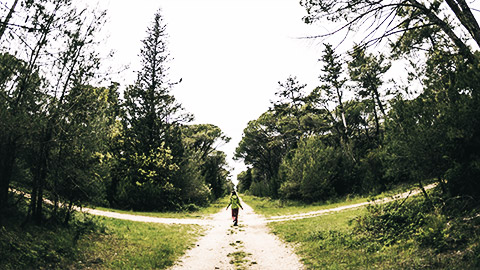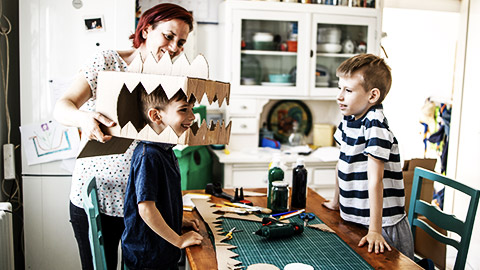In this chapter, we will discuss topics relevant to ethical practice in identifying and responding to children and young people at risk, including principles that guide ethical practice and ethical decision making, working within professional and job role boundaries, using ethical and nurturing practices, reporting ethical concerns and seeking supervision and support when required.
By the end of this chapter, you will understand:
- The rights of children in regard to ethical considerations
- The key ethical principles for working with children and young people
- Where to locate relevant codes of ethics
- A range of ethical concerns you may be faced with
- Appropriate responses to ethical concerns
Being impartial and non-judgemental is a part of justice and equity

Child protection is a very sensitive area full of ethical dilemmas. Decisions about children at risk can have serious consequences, so acting in an ethical way is essential.
Ethical dilemmas are about deciding the right thing to do in a situation. Ethical issues and legal issues may overlap, but they are not the same. You must act within the law, but you must also consult relevant codes of ethics, codes of practice, service standards and other sources of information about ethical practice for your industry sector.
Watch the next video explaining Ethical Dimemas and what does it mean?
The following are outlines of some broad ethical principles that apply to all community services work:
Beneficence
This means doing good and avoiding doing harm. It may include protecting the weak and vulnerable, and advocating for and defending their rights.
Justice and Equity
This means being fair and avoiding discrimination. It also means that rules of behaviour should be applied to all people equally. Being impartial and non-judgemental is a part of justice and equity.
Respect
This means treating everyone with respect for their rights, dignity and autonomy. Respecting others includes being truthful, honest and sincere.
Accountability and Transparency
To be accountable is to be responsible for your actions. Accountability also means that someone else can check to see if you have followed the rules when making a decision. This principle is linked to transparency, which means not making decisions in secret, showing you are following principles and rules, and being open and honest about your actions. You must also be able to explain and justify your actions and decisions with reference to relevant legislation, policies, procedures and guidelines.
Confidentiality
Confidentiality means not sharing information about someone without their knowledge and consent. This can be difficult in a child protection context because a child who discloses information about abuse or neglect might ask you not to tell anyone about it – but to keep the child safe, you will have to tell someone.
Breaching confidentiality is justifiable in the following circumstances:
- In order to prevent harm to a person
- When the information has been requested by a court
Next, let's watch this video explaining General Ethical Principles.
Our own personal values and beliefs will inevitably come into play when we are faced with an ethical dilemma. We cannot ignore our own values and beliefs, but when we are working in a professional capacity, we must ensure that we are open about values and beliefs that might affect how we reach a decision about an ethical issue.
If our own personal values will not allow us to act fairly or impartially in a situation, support a workplace standard or meet an ethical requirement, we should state this clearly and seek advice from a supervisor. For example, a worker who has a strong belief that it is wrong to terminate a pregnancy for any reason might find it difficult to support a woman who is pregnant as a result of rape and seeking a termination. In such a case, the worker should make their beliefs explicit and discuss with a supervisor whether or not they are able to act impartially. As another example, a worker who strongly believes that paedophiles are unredeemable sinners will find it difficult to work with perpetrators of child abuse.
Next, we have a 2-minute video explaining values, beliefs and attitudes definitions.
Note
Awareness of our own values and beliefs and how they influence our work practice is an essential part of professional practice.
Values, beliefs and ethics are interrelated: Values are fundamental beliefs about what is worthwhile and good. Beliefs are thoughts that person perceives to be true. Values and beliefs guide our actions and help us decide what is important. Ethics are standards, principles or guidelines that indicate what is ‘right’ or ‘moral’ and tell us how we should behave.
We develop our values, beliefs and ethical standards as part of our socialisation into our culture and society, and in response to our own individual experiences. We learn them from our family (meaning those who acted as our parents and raised us), religious institutions, the education system, our peers, influential cultural figures who we admire and our personal experiences.
Note
Reflecting on our own values and beliefs can be challenging. We often take them for granted until we encounter a situation that challenges them.
It would be beneficial to read a code of ethics relevant to your area of work and compare your own values and beliefs to those expressed in the code. Ask yourself whether there are any conflicts, and if there are, how you could resolve them.

When we are making decisions about the right thing to do in a particular situation, there are several sources of information that we can consult, including:
- Relevant laws and legislation
- Government policies and guidelines
- Industry standards, policies and procedures
- Codes of ethics, codes of practice and codes of conduct for our industry sector, profession or organisation
When handling a child abuse or neglect scenario within your work role, it is imperative that you:
Act within the law
Check your state/territory legislation and find out what it requires you to do. Your legal responsibilities are part of your framework for reaching a decision. In the case of a child protection issue, consult the policies, procedures and guidelines provided by your state/territory child protection authority.
Consider your duty of care
You should also think about your duty of care and what you must do in order to meet your duty of care in the situation. What are the risks? What is a reasonable response to these risks?
Check your job role description/duty statement
Working within professional boundaries and your job role is an important part of ethical practice. It may not be your direct responsibility to deal with a child protection issue. If this is the case, you should report your concerns to your supervisor. If you need to take immediate action to keep a child safe, do so and then report to your supervisor.
Check industry standards
Some community care sectors, such as aged care and disability services, have legislated service standards that providers must meet. These can be useful guides to consult.
Codes of Practice and Codes of Ethics
Codes of practice and codes of ethics are very similar:
- Codes of ethics tend to be applied more widely
- Codes of practice may be more specific to an occupation, profession, industry sector or organisation.
Note
Codes of practice and codes of ethics support human rights and the rights of service users. A resource for Early Childhood Educators is the ECA Code of Ethics.
Case Study

The service director has called a staff disciplinary meeting for an educator who has disciplined a child inappropriately in the Preschool Room. The educator smacked the child during group time because they were not listening.
The director has asked for you to be an independent witness for this meeting. In the meeting, the director discussed with the educator the poor conduct on their behalf and how they have breached the Service Philosophy, the National Law and Regulations, the ECA Code of Ethics and the UN Convention on the Rights of a Child. From this, the director terminated the educator's employment.

You will recognise when you are experiencing an ethical dilemma because there will be more than one set of values and interests involved in the situation and you will need to decide which of them is more important. Within a child protection context, your primary responsibility is towards the child – this much is always clear. How best to protect and safeguard the child and respect their rights is not always quite so clear.
Watch this video explaining the meaning of an ethical dilemma.
Some of the factors that complicate making ethical decisions include:
Competing rights and duties
For example, you may be working with a family. You are friends with the parents and see them in events outside of the service, and a parent is using drugs. The parent has a right to self-determination and to make choices, but you have a duty to protect the children from harm.
Competing obligations
For example, you may be working with a family in which the child at risk is not your primary client, and you become aware of the risks to the child in the course of working with another family member of theirs. To whom would you owe an overriding duty of care?
Competing values
For example, your personal values may conflict with the action that you are expected to take in your work role. The acronym DECIDE represents a simplified version of the steps you can take to help you make an ethical decision:
D: Define the problem
E: Ethical reflections
C: Consider options
I: Investigate possible outcomes
D: Decide on actions
E: Evaluate results
For more information on making ethical decisions that apply to workers as well as to managers and organisations, visit the following link:
‘Information Sheet: A Guide to Ethical Decision Making’ from the New South Wales Council of Social Service
Watch this video about Ethical Decision making.

Children and young people who have experienced or are experiencing abuse and neglect are very vulnerable, so you need to be especially sensitive to their needs and provide nurturing support.
To nurture someone means to support them in a caring way. Nurturing helps a person’s growth and development, and can help to heal injuries and hurts. Multiplying Connections states that, with children, nurturing involves ‘validating their feelings; providing physical affection and comfort when sought; laughing and playing games; providing safe mental, physical and social challenges that promote healthy growth’.
Note
It is important to check your organisation’s policies on touching and showing physical affection to children, as this may not be appropriate depending on your job role and the context of the service that you are providing.
Trust and Working Ethically

Trust is an important aspect of nurturing practices, and behaving ethically is an important element in establishing a trusting relationship.
Working Ethically With Children and Young People
Working ethically means safeguarding the rights and interests of children and young people. It includes:
- Treating everyone with respect
- Including children and young people in making decisions that affect them, where possible
- Maintaining confidentiality when appropriate and safe to do so
- Avoiding bias and discrimination, and maintaining a nonjudgemental attitude
- Responding appropriately to indicators of harm and risk
- Following legislative requirements and a relevant code of ethics when you are making decisions
- Working within your organisation’s policies, procedures and code of conduct
- Seeking further support and advice when needed
- Keeping your professional skills and knowledge up to date and in line with current practices/policies
Connection to the National Quality Standard
When working with children this connects directly with the outcomes from the National Quality Standards- Quality Area 5, Relationships with Children.
Quality Area 5 of the National Quality Standard focuses on educators developing responsive, warm, trusting and respectful relationships with children that promote their wellbeing, self-esteem, sense of security and belonging. Relationships of this kind encourage children to explore the environment and engage in play and learning.
All children need a sense of connection with others to support the development of their identity and social and emotional competence. From birth, children begin to explore how the social world works. Exploring and learning to socialise appropriately with others, and to manage feelings, behaviours and responsibilities is a complex process. When educational leaders, co-ordinators and educators take a positive, strengths-based approach to guiding children’s behaviour, they ultimately empower children to regulate their own behaviour and develop the skills needed to interact and negotiate effectively with others.
Relationships with peers take on increasing importance for older children. Supportive relationships with educators enables older children to develop confidence in their ability to express themselves, work through differences, engage in new experiences and take calculated risks.
| Quality Area 5 | Relationship with children | |
|---|---|---|
| Standard 5.1 | Relationships between educators and children | Respectful and equitable relationships are maintained with each child |
| Element 5.1.1 | Positive educator to child interactions | Responsive and meaningful interactions build trusting relationships which engage and support each child to feel secure, confident and included |
| Element 5.1.2 | Dignity and rights of the child | The dignity and rights of every child are maintained |
| Standard 5.2 | Relationships between children | Each child supported to build and maintain sensitive and responsive relationships. |
| Element 5.2.1 | Collaborative learning | Children are supported to collaborate, learn from and help each other |
| Element 5.2.2 | Self-regulation | Each child is supported to regulate their own behavior, respond appropriately to the behavior of others and communicate effectively to resolve conflicts. |
You may encounter situations in which another person is behaving unethically and perhaps putting children and young people at risk.
For example, a colleague who gossips about clients and their families or who behaves inappropriately around children and young people, or a colleague who steps outside professional boundaries in their relationships with clients is behaving unethically.

In these situations, your first step should be to talk to the person and express your concerns. Always focus on the behaviour rather than the person. We respond better to constructive feedback than we do to personal criticism. If this is not possible or is unsuccessful, you may need to report the unethical conduct to your supervisor or someone else in authority.
Reporting Unethical Conduct
When reporting unethical conduct:
- Follow your organisation’s policies and procedures
- Refer to your organisation’s code of conduct, a relevant code of ethics, service standards or legislation.
- Describe your observations accurately, clearly and objectively.
- Avoid personal and emotive comments.
In reporting unethical conduct, include information about:
- Who is involved
- What happened, when and where
- Why you believe the conduct to be unethical, citing relevant legislation and/or policies, where appropriate
- Any actions that you have taken and the responses to those actions

Reporting Conduct and Guidelines
When reporting conduct you must ensure that you follow the correct process/ procedure whether it be internally or externally to the service.
- Internally: This may require you to report/ talk to either the Responsible Person (room Leader, person in charge of the shift), Nominated Supervisor (the centre director/ supervisor, who runs the service), the Approved Provider (the owner of the service, if it is privately owned, or potentially an area manager if it is company-owned).
- Externally: this may require you to report to an external stakeholder depending on the situation, this could include the Office of the Children's Guardians, The Regulatory Authority for your state/territory or if needed Emergency Services.
- Information: the best source for you to find out the best practice and the process is looking at the services policies and procedures as they should be able to inform you of best practices. If you are unsure of how to best approach the situation, you can contact your Regulatory Authority Information Line. You can call them and ask to remain anonymous and they can direct you on the best course of action.
Case study

You are working in an early childhood environment with children 0-6years. In the three-year-old room where you are working, one family has asked you specifically to not let their child fall asleep at rest time. Jack is three and often starts to show signs of tiredness at lunchtime by rubbing his eyes and lying down in the book corner.
At rest time, the child, Jack, is given a bed but you also provide him with some games and puzzles to play within the hope he will just have a rest, but he still falls asleep.
What should you do?
You are not sure what to do. Should you tell the family he fell asleep, even though you know they will be angry. One of the other educators in the room, says that you should just say he did not fall asleep and lie about the fact that he fell asleep.
Are you comfortable with this? What would you do? What are your professional boundaries?

A professional boundary is the line between acceptable and unacceptable behaviour and emotional attachment in relation to a child (or a child’s family) within or outside your place of work.
Watch this next video about the value of boundaries.
Crossing of professional boundaries happens when you allow or initiate behaviour that compromises your professional relationship with a child and/or family, when the nature of the relationship moves from a professional one to a personal one and/or is clearly harmful to or exploitative of a child and/or family.
Crossing professional boundaries include:
- Accepting or giving money and gifts
- Giving a client or their family special treatment and showing favouritism
- Disclosing and sharing private or personal information about yourself
- Providing your personal contact details, such as your personal phone number or social media accounts
- Social networking (e.g. communicating with a client or their family on Facebook or similar platforms)
- Contacting or visiting a client or their family outside your normal working hours
- Inviting a client to your home or including them in your family’s activities
- Participating in a client’s social activities when this is not within the remit of your role
- Any sexual relationship with a client or client’s family member
Some of these behaviours may be well intentioned, and they may seem innocuous, but they can result in harm to your clients and to yourself.
Working within professional boundaries is particularly important when working with vulnerable people. Blurring the boundaries of a professional relationship results in confusion about roles and expectations. For example, becoming a client’s ‘friend’ can lead to unrealistic expectations, resulting in hurt and distress when these are not met. It can also increase stress for a worker who is already working in a demanding industry and may damage professional reputations.
Working outside your job role and undertaking duties outside your area of competence can also have legal implications. It may result in breaches of your duty of care, and if harm results from this, you will not be protected by your employer against any legal action for negligence.
Note
If you are asked or instructed to take on tasks and activities that fall outside your job role, discuss this with your supervisor and always ask for these instructions to be given in writing so that you have a record of them.
Use your best judgement and do not take on any tasks and activities for which you do not have the skills, knowledge and competence.
Guide to the NQF
In the Guide to the NQF, there is an entire standard dedicated to Staffing Arrangements that looks at Professional Collaboration and Professional Standards of educators working with each other, children and families.
Professionalism is demonstrated when management, educators and other staff develop and maintain relationships with each other that are based on the principles of mutual respect, equity and fairness. Team collaboration that is based on understanding the expectations and attitudes of team members, and build on the strength of each other’s knowledge, help nurture constructive professional relationships. These relationships reduce the likelihood of misunderstanding and conflict. For more information see Early Childhood Australia’s Code of Ethics (2016), a resource that guides the behaviour of early childhood professionals.
When adults communicate effectively and respectfully with each other they promote a positive and calm atmosphere at the service, supporting children to feel safe and secure and contributing to the development of positive relationships between children and educators. Unresolved and poorly managed conflict between adults in the service affects morale and impacts on the provision of quality education and care to children.
Services support staff to act cohesively and ethically as a team and provide an environment that is conducive to children’s learning and development. This may be reflected in the service’s statement of philosophy (see Element 7.1.1).
| Standard 4.2 | Professionalism | Management, educators and staff are collaborative, respectful and ethical |
|---|---|---|
| Element 4.2.1 | Professional collaborations | Management, educators and staff work with mutual respect and collaboratively, and challenge and learn learn from each other, recognising each other's strengths and skills. |
| Element 4.2.2 | Professional standards | Professional standards guide practice, interactions and relationships |

Q1: List and describe 3 general ethical principles.
Beneficence, Justice and Equality, Respect, Accountability and Transparency and Confidentiality.
Q2: Describe the rights of the child that need to be considered when making ethical decisions regarding child abuse.
Relevant laws and legislation, Government policies and guidelines, Industry standards, policies and procedures, Codes of ethics, codes of practice and codes of conduct for our industry sector, profession or organisation, Act within the law, Consider your duty of care, Check your job description and role, Check industry standards, Codes of practice
Q3: How can your personal values and beliefs impact your ethical decision-making?
Competing rights and duties, Competing obligations, Competing values
Q4: What is the difference between codes of ethics and codes of practice?
Some scholars distinguish a code of practice from a code of conduct. A code of conduct is defined as a practical document of standards governing client relationship, and a code of practice, as a technical document setting standards for the members of a profession.
Q5: What are some ways you can set professional boundaries.
A professional boundary is the line between acceptable and unacceptable behaviour and emotional attachment in relation to a child (or a child’s family) within or outside your place of work. An example could be: leaving work at work, being professional at work, following the centre's policies and procedures, do not get involved with workplace gossiping and bullying.

